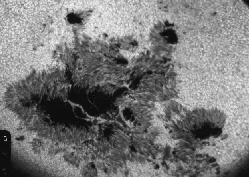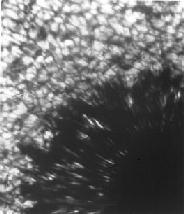
| Granulation of the Photosphere |
 |
| Granulation near sunspot group |
 |
| Granulation region |
In these columns hot gas rises with a velocity of several kilometers per second (this can be confirmed by Doppler shift measurements). The tops of these columns are the brighter gray-white cells seen in the granulation images. The hot gas then cools at the top of the column and sinks down in the darker regions surrounding each granule.
Thus, granulation just represents the tops of convection currents that
are transferring heat from below the solar surface to the surface. In that
sense, granules are a little like the tops of cumulus clouds in the Earth's
atmosphere, which are also associated with convection currents.